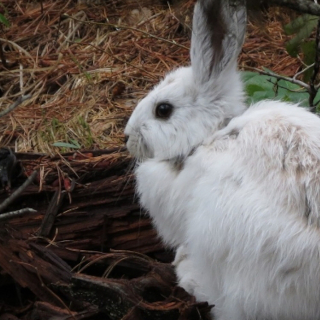Predator and Prey, Highs and Lows of Field Research

I’ve been beyond fortunate to have spent the last year working with the lab in our new study area in the central Oregon Cascades, getting our new projects off the ground and into the hands (or big fluffy feet?) of the local snowshoe hares. Scott and I first came out here in April 2020 when the snow was piled high and a day in the field meant cold fingers and soaking wet boots. Then came the first blooms of trillium and lady slippers, the wren and warbler song, ferns that grew taller than me, and a couple of excellent field hands to stumble through them with. We had several months in the sun and mosquitos before the nights lengthened and chanterelles sprang up after the first fall rains. In time, the hares molted back into their winter coats and now I’m back to stomping around in snow drifts, dreaming about flowers and warmth. Witnessing every season in the study area has been amazing, and each has had its unique challenges. Our study area is dynamic, encompassing a strong elevational gradient and unpredictable weather patterns that have created perfect conditions to support the polymorphic population of winter white and winter brown snowshoe hares that we’re studying. Things change quickly, but at least the unpredictability remains predictable!

Calypso bulbosa aka fairy slippers or Calypso orchid growing at one of our study sites
Sometimes my mental state and contentment with a day’s work can change as quickly as the weather up here. To gather the data that we need to understand hare responses to rapid climate change, we need to trap and release individuals with radio-collars. Live trapping itself has some inherent challenges. Even if you take every step to provide animals with quality care – adequate food, hydration, shelter, frequent trap checks – the bottom line is that you are still holding a wild animal captive and unable to navigate its habitat safely. Once a hare enters a trap, it’s in our hands. But every once in a while, someone else gets their paws on them first. Early in the morning last week, I went out to check our traps and came upon a nasty scene – one of our collared hares had been attacked in the trap and partially consumed by a predator. I took her remains out and tried to remove the collar, but needed to retrieve a tool from the truck to do so. I was bummed out and feeling sorry for our furry friend who I had just met five days prior. Free ranging hares regularly meet grisly ends like this, but it’s hard not to feel guilt when it happens while they are under my care. My job revolves around collecting data while prioritizing the animals’ safety and wellbeing, so it hurts when my efforts are thwarted. I somberly checked the rest of our traps and returned to retrieve our collar.
But it was gone! Whoever got our hare was not interested in giving up the rest of their easy meal. I cursed them for a moment before running back to the truck and grabbing our VHF radio telemetry receiver and antenna and charging back into the snow after the collar signal. I was well aware that I probably wouldn’t see the perpetrator - that if it hadn’t already taken our collar into a den, it would disappear when I approached on noisy snowshoes. Fortunately, I found the rest of the hare in a tree well, looking a little worse for wear. I removed the collar and almost walked away before I had an idea. With no more hares to process and a few hours until lab meeting, I could afford to wait and see who had taken our hare. I took the remains and placed them on a snow heap in a small clearing and walked off about thirty yards through the trees. Then, I just sat quietly behind a snow drift and tried to be as inconspicuous as a big dumb loud smelly human in colorful rain gear can be in the forest.
About ten minutes later, I saw a pair of pointed ears across the clearing. After a few moments they turned sideways, then back at me. The creature stepped out and I saw its profile – no long snout, and pointed furry cheeks – a bobcat! It moved silently into the clearing, where sunlight streamed through the branches onto its back, revealing a beautiful grey coat with black splotches. In a moment, it was gone again, but my mood had changed completely. My first bobcat sighting! This amazing animal is just trying to survive life in the Cascades. If you left a platter of chocolate chip cookies out for me in the woods, I would eat them too. I am still sad for our hare, but she was only one individual in an ecosystem that is rich, amazing, and dynamic. One of my darker days in the field quickly became a highlight in the same way that the clouds will clear in a moment in the Cascades. Unpredictability is a part of the natural world and I feel lucky to experience it so directly in our field work– it keeps me honest, even if it isn’t always easy to work with. It’s been a wonderful year with the Mills Lab and I think the sunny days still outnumber the sopping wet ones (….debatable…). I’m looking forward to more of it either way!
Amanda Emmel, Field & Lab Manager/Lead Technician
Feature Image: A VHF radio-collared hare checking out one of our baited camera traps
